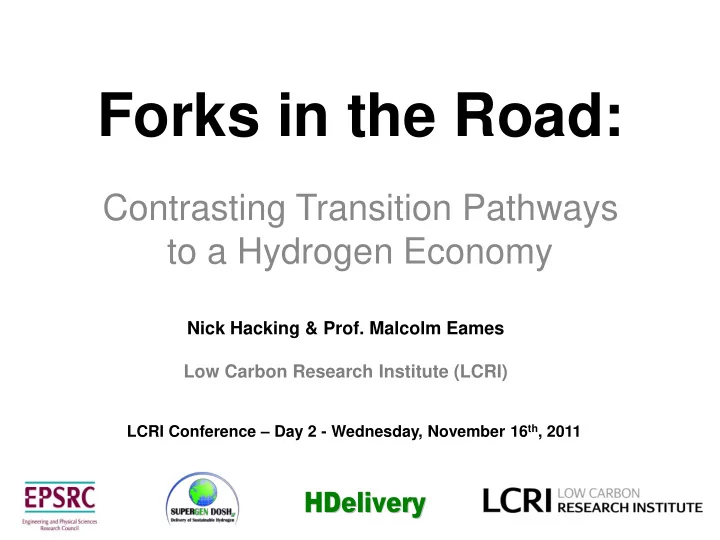

Forks in the Road: Contrasting Transition Pathways to a Hydrogen Economy Nick Hacking & Prof. Malcolm Eames Low Carbon Research Institute (LCRI) LCRI Conference – Day 2 - Wednesday, November 16 th , 2011 HDelivery HDelivery
SUPERGEN XIV Consortium • Aim : “deliver new technologies capable of clean and cost-effective conversion of low- carbon electricity and various carbon sources, including biomass and waste, into hydrogen” • Aim : “achieve significant critical mass and provide a proactive consortium, well-linked to a range of industrial actors, to address these major long- term problems”
WP4.2 – International Comparison • Aim 1: to understand innovation as the result of social process involving actors, networks, institutions and resources, • Aim 2: offer policy advice on delivering sustainable hydrogen to the consortium, government and other stakeholders.
Methodology • Literature review: i) innovation studies, ii) social constructivism (how technology & learning link), iii) hydrogen-specific research. • Empirical case studies : UK & Germany, • Quantitative & qualitative data : inc. expert interviews coded in NVivo software, • Analysis & conceptual development: advancing existing perspectives on innovation & energy transitions.
Innovation Systems • Aim : understand innovation as the result of co- evolutionary, enacted, relational and interactional social process involving actors, networks, institutions and resources • Focus: National Systems of Innovation (NSIs), Regional Innovation Systems (RISs), Sectoral Systems of Innovation (SSIs) • Recent model : Technology Specific Innovation System (TSIS or TIS) - understand the global development of specific technologies and the relationship between NSIs and SSIs
Innovation Systems Four-country technology-specific innovation system (TSIS) (Hekkert et al, 2007)
Functions of Innovation Systems ‘Motors of change’ in a TSIS – A, B & C feedback loops ( +/- ) (Hekkert et al, 2007)
Case Study: UK source : UKHA (2008)
Case Study: UK Positives: • a strong science base with strengths in H 2 production & storage R&D, • a number of regionally-based hydrogen demonstration projects, • private-sector actors with interests in hydrogen technology, • an interviewee from a multinational says, “In the UK, we have moved beyond the demonstration stage. We‟re ready for the market.”
Case Study: UK Negatives: • lack of a top-down, politically-sanctioned medium- to long-term vision, • the short- term trading emphasis of Britain‟s capital markets, • persistent under-resourcing and under-valuation of education and training, • less effective institutional links between universities doing hydrogen RD&D and regional development agencies (RDAs), local planning authorities (LPAs) and private enterprise, • the lack of home-grown R&D in the automotive sector may be a significant factor in terms of lack of government political priority and strategic support leading to poor funding allocation, • national policy makers have largely focussed on electric vehicle prospects.
Case Study: UK 70 60 50 40 positive negative 30 20 10 0 Entrepr Activs (Influ) Legit-Lobby Legit-Lobby (Influ) Mark Form Mark Form (Influ) Entrepr Activs Feedback Loop A - coding reference counts
Case Study: UK 80 70 60 50 40 positive negative 30 20 10 0 Entrepr Activs (Influ) Legit-Lobby (Influ) Res Res Alloc-Mobilize Knowl Creation (Influ) Knowl Creation (Influ) Knowl Diff v Nets (Influ) Legit-Lobby Alloc-Mobilize (Influ) Knowl Creation Knowl Diff v Nets Entrepr Activs Entrepr Activs Feedback Loop B - coding reference counts
Case Study: UK 60 50 40 positive 30 negative 20 10 0 Entrepr Activs (Influ) Guid of Search-Expects Guid of Search-Expects (Influ) Knowl Creation Knowl Creation (Influ) Entrepr Activs Feedback Loop C - coding reference counts
Case Study: Germany • Memorandum of Understanding (MOU) signed between the German government and major automobile manufacturers, gas companies and energy utilities (2009), • H 2 Mobility programme - coordinated cross-sectoral approach to rolling out mass-produced hydrogen fuel cell vehicles by 2015 (or earlier), • Konjunkturpaket II programme - investment in public hydrogen refuelling network - part of an economic stimulus package, • H 2 Mobility & Konjunkturpaket II help to meet Europe‟s low carbon targets for 2050 whilst simultaneously boosting German domestic economy.
Case Study: Germany German public H 2 fuelling stations (2009) = 5 German planned hydrogen fuelling stations: 2013 = 159 2015 = 500 UK public H 2 fuelling stations (2011) = 1 2017 = 1,000
Case Study: Germany Initial Analysis of Interviews: • the importance of a collectively agreed public-private vision for hydrogen‟s future development, • the ability of the sixteen fully devolved Länder to boost funding for national and supranational hydrogen projects especially in certain cities like Hamburg and Berlin, • the historically close institutional links between certain academic researchers and industry, • “It‟s really about innovation and innovation isn‟t just about novelty,” said one participant. “It‟s about bringing novelty to the market. [This is when] you need a stronger input by industry.”
Initial Conclusions • data & anecdotal evidence suggests UK & Germany are on very different „innovation paths‟ re. moves towards sustainable hydrogen in their national economies, • this is due largely to different: a) political visions/commitments, b) national economic & political structures, c) industry-university research links, d) skills bases, and e) investor return horizons.
Initial Conclusions • possibly enhance analysis by putting more emphasis on the learning that takes place and the power relations between actors, for example, • analysis planned for around 50 actors in total (plus quantitative data indicators) to be concluded during 2012.
Recommend
More recommend